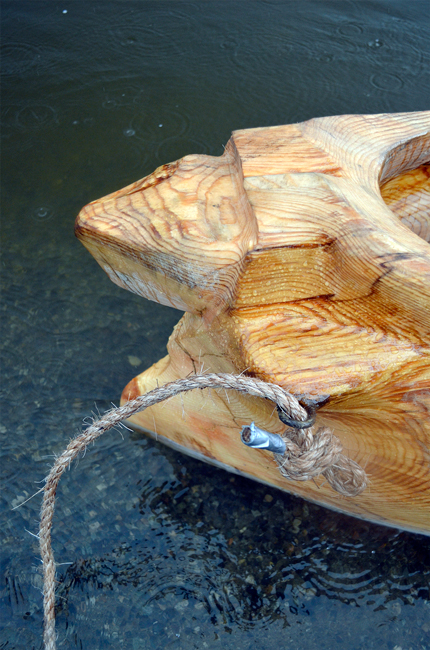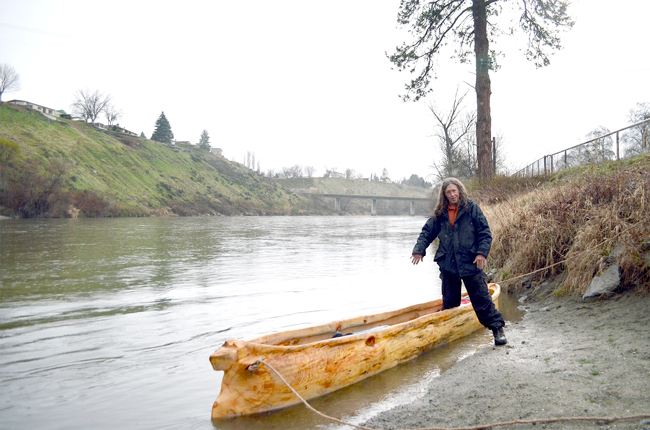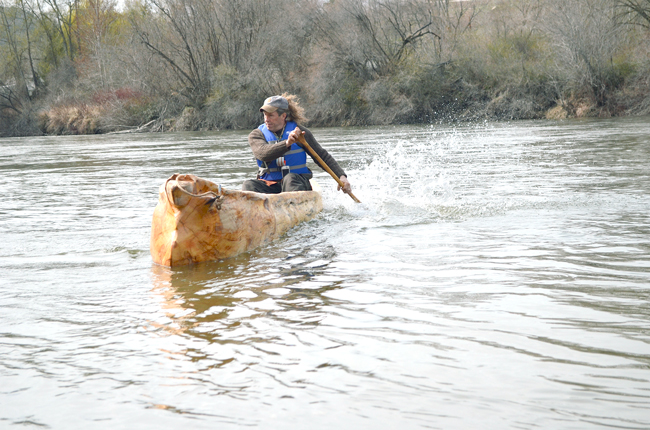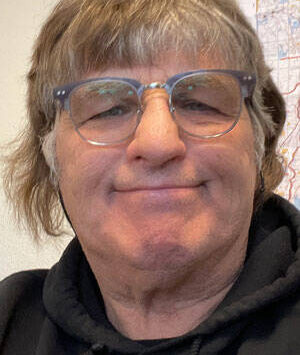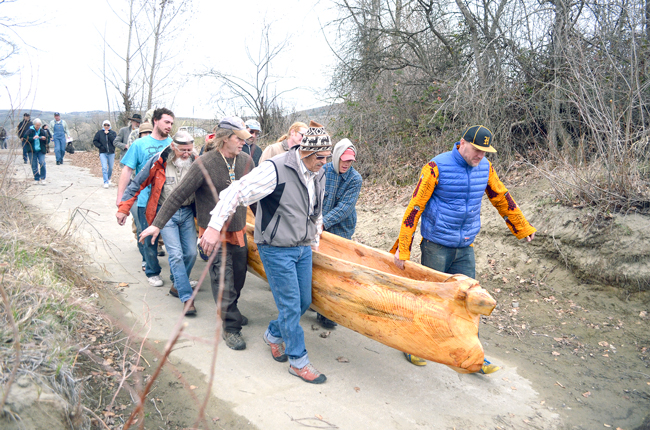

SHAKEDOWN CRUISE
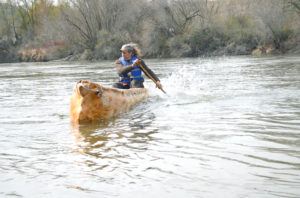

TONASKET – Crazy Mary entered the waters of the Okanogan River for her christening voyage Sunday, March 22, at Chief Tonasket Park. Steering her was her creator, William Clark’s great great great great grandson Churchill.
Clark found the tree a couple years ago after a windstorm in Republic took her down. She may have thought her life was over, but it was just about to get good. A Ponderosa Pine, Mary was hauled to the Okananogan Highlands by Dave Konz.
“We slabbed it in two, loaded her into a dump truck and dropped her off at the Barter Faire site,” said Clark. Her emergence from the trunk began in October, 2013 on Artist Row at the Barter Faire, with Clark as the featured artist and hundreds of volunteers chipping in with an adze over the four-day event.
Named after a Pearl Jam cover of a song by Victoria Williams, Clark said the canoe’s name came to him “very late” in the process, just this past December. The making of the canoe can be viewed in a video called “The Unveiling of Mary the Dugout Canoe” on Clark’s website, Dugout Canoe Love.com.
Her true transformation, however, happened with Clark paddling her upriver for a short spin on the Okanogan before returning to friends and spectators gathered onshore.
“It’s official. Crazy Mary is now a canoe,” announced Clark jubilantly. “I love it. I am so ready for this.”
Clark himself seems transformed, with a wide smile shooting across his face now that he’s on the water with a beloved boat.
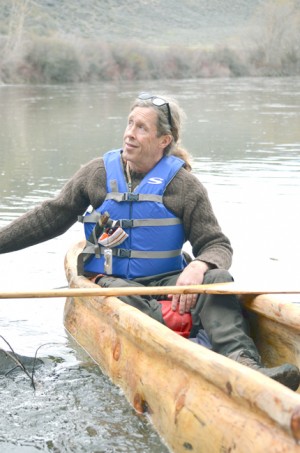

“She’s about the people. These trees bring people together and put a smile on their face,” Clark said.
“The canoe brings people out of the woodwork,” said Ephraim Brown, enlisted to drive Clark’s truck from the launch site. “His journey is magical.”
Descended seven generations away from Clark’s firstborn son William Meriwether Lewis Clark, Clark was privy to reading his relative’s journals during preparation for a two-and-a-half-year-long bicentennial reenactment of Lewis and Clark’s Corps of Discovery trip. Asked what stood out the most for him from the journals, Churchill shrugs. Perhaps the inkings were simple log notes, devoid of the musings of the descendant to follow.
“People are capable of amazing things. This is truth. We are not helpless,” Clark says on a video posted on his website. “We do not need to be saved. We don’t need someone to take care of us. We need to live, and live strongly with our hearts. Roll with it. Learn to do it.”
Clark can certainly lay claim to “learning to roll with it.” An accident left him blinded for three years before surgery restored his sight. Rather than laying down his life and waiting patiently to take it back up again, he took on a Cottonwood and started digging her out. Knotty the Dugout Canoe was born, and Clark paddled her, still blind, following the Platte River across Nebraska.
“I tell you…from my experience…that your life will change forever and so will so many of the lives around you,” Clark states.
Brown recalled first meeting Clark after his sight was partially restored.
“He’s blind in one eye, he’s got metal in his legs, and still he’s carving on a canoe. To see someone that dedicated, it’s pretty hard not to get inspired,” said Brown. “You see this magical thing come into your life, and to be able to help…how can you not?”
Clark called to say he was approaching Omak at 7:40 a.m. Tuesday, March 24. “I got out before sunrise—I still haven’t seen the sun because it’s raining—but I’m coming into Omak.”
He pulled Crazy Mary up to shore around 9 a.m. at the Omak Stampede grounds, just across the river from the Suicide Race.
“I had a great float today,” he announced happily. “I just broke my tent down when the rain started. I wasn’t waiting for the sun to come up, because I wanted to get out. I don’t usually paddle in the dark unless there’s a full moon—especially on a river I don’t know, but I wanted to be sure and be here in time for the kids.”
He was expecting the students to arrive around 12:45 p.m.
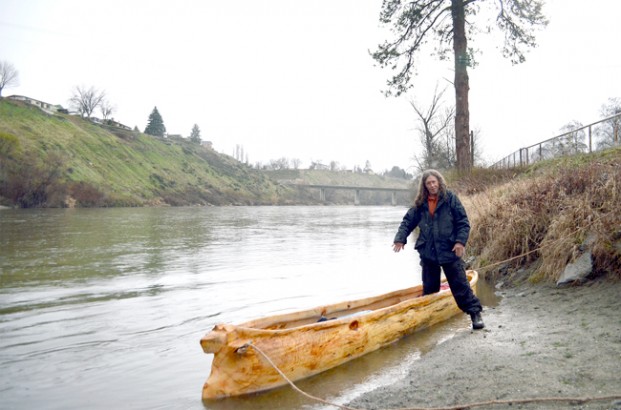

“I swamped her coming into Riverside,” he said. “At the big falls way up river, she was a rock star. I pulled over on an island and saw the falls; I couldn’t tell where I was hitting it. We got good washers or rollers or whatever; whitewater. But the worse one was coming into Riverside. No one told me about it. Had I gone to the left I would have been okay. But I just came up on it and it was a bit of a surprise. I heard a lot of noise, and saw some big rocks. I shot them, and took some water on at the bottom and had to pull over and bail her out.”
He said he took on a lot of water, so the bailing took long enough for him to get cold.
“But she can’t flip; you can lean hard to either side and she won’t flip,” he said.
Clark spent Sunday night, March 22, “between the rapids and falls on an island,” and was offered a place in Riverside Monday evening where he was able to park his canoe at the host’s boat ramp.
He said he guessed the float down to Omak took three or four hours.
“She is quirky,” Clark said. “One thing with my canoes is, if you want something symmetrical and predictable, you don’t want one of my canoes. But if you want to get to know her and feel how to ride her, then these are the canoes for you. I leave the natural curves in place, so she responds different to either side.”
Clark said part of the fun for him is that every canoe is different.
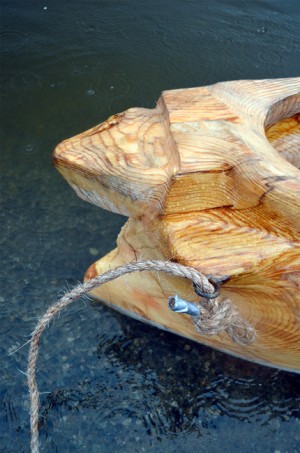

Clark said Crazy Mary is the first canoe he was considering selling, with an asking price of $15,000.
He may never be convinced to sell the canoe he dug out while blind. In a video called ‘Knotty Gets Delivered’, Clark returns to Livingston, Montana, where the canoe had been stored at the Yellowstone Gateway Museum. As a crew of firemen carry her down the stairs, Clark says on camera, “I’m finally seeing her for the first time. The canoe that I made and paddled across Nebraska two years ago. And let me tell you, it rocked my world. It’s kinda like smelling rain for the first time.”
He recalled the event as he stood onshore Tuesday. “I was in tears. I couldn’t believe it. I just thought, she looks great. I’ve never seen her before, and now I could see her grain and everything.”
Future carves include doing canoes for the Dakota Sioux in Poplar, Montana; and another for MHA Nation comprised of the Manden, Hidatsa and Arikara Tribes in New Town, North Dakota.
“The elders tell me, “We don’t have any carvers anymore,” Clark said.
